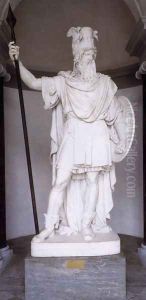Bengt Erland Fogelberg Paintings
Bengt Erland Fogelberg was a prominent Swedish sculptor born on August 8, 1786, in Gothenburg, Sweden. He was the son of a stonemason, which gave him early exposure to stone carving and sculpture. Fogelberg demonstrated a strong inclination towards art from an early age and was encouraged to pursue his talents. In 1808, he moved to Stockholm where he began his formal training in the arts. During his time in Stockholm, he attended the Royal Swedish Academy of Arts, which played a crucial role in shaping his career as a sculptor.
In 1818, Fogelberg traveled to Rome, which was a significant center for artistic learning and production at the time. This move marked the beginning of a period of extensive study and work that would last for many years. In Rome, he was exposed to the works of classical antiquity and the Renaissance, which greatly influenced his style and technique. He became part of a circle of Scandinavian artists working in the city, and his skills grew under the influence of the neoclassical artistic environment prevalent in Europe during that period.
Throughout his career, Fogelberg produced a number of notable works, many of which reflected his mastery of neoclassical style. His sculptures often drew upon mythological themes and demonstrated a keen understanding of human anatomy and form. One of his most famous works is the statue of the Norse god Odin, located in the Gothenburg Museum of Art.
Despite spending much of his life in Italy, Fogelberg maintained strong ties to his homeland. His works were sought after in Sweden and contributed to the development of Swedish national identity during the 19th century. He was commissioned to create public monuments, which included statues of significant historical figures such as Gustavus Adolphus and Charles XIII of Sweden.
Bengt Erland Fogelberg's contribution to the arts was recognized by his appointment as a member of the Royal Swedish Academy of Arts. He was also honored with an order of knighthood in Sweden. He continued to work and create art until his death on December 22, 1854, in Stockholm. His legacy endures through his sculptures that still stand in public spaces and collections, reflecting the neoclassical ideals of beauty, form, and craftsmanship that characterized his life's work.
